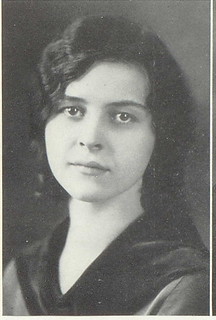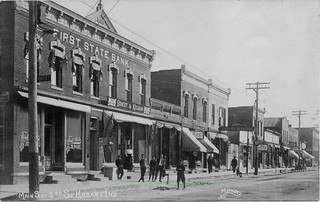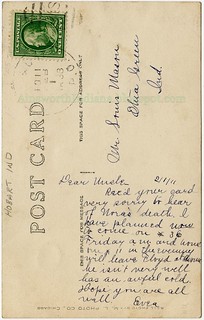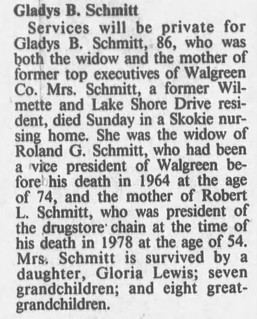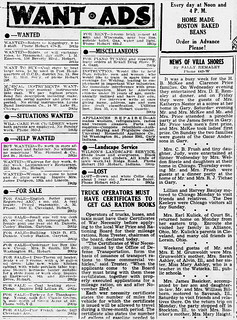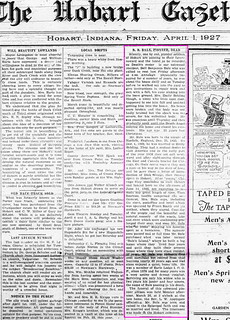Let's take another look at those statements of account from my
last post.
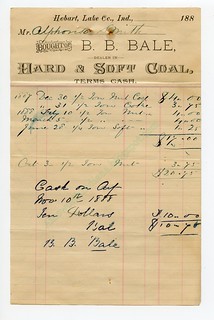
(Reverse of the above:)


Who (you might ask) was that Alphonso Smith guy who bought all that coal from B.B. Bale?
Searching on that name in that place on Ancestry.com brings up only one record: the
1870 Census, where he's a boy of 14 living in the household of Fanny Smith, in Hobart.
 (Click on image to enlarge)
(Click on image to enlarge)
Image from Ancestry.com.
This census did not record how household members were related to each other. It didn't take me long to find out that Mariam Brock was Fannie's daughter, and Carrie Brock her granddaughter. But no other records places Alphonso and Fannie together in one household.
However, in the
1860 Census, Fannie's household includes a boy named Bernett who was then four years old — born the same year as the 1870 Alphonso. Once we assume they are the one and the same, it becomes easier to find this coal-purchasing guy. He was Bernett Elfonso Smith — and yes, it seems he spelled his middle name with an
E; only when other people are writing it does the
A appear.
[1]
I think it was he who signed that promissory note to B.B. Bale:

Part of the signature was lost, but you can see the
E plainly enough.
Bernett Elfonso was born to Henry and Fanny (Wheeler) Smith circa 1856. That was probably the same year his father died. His parents were in Porter County for the
1850 Census, but by 1860, as we've seen, the family moved to Hobart. There the widowed Fanny raised her children and spent the rest of her life. Although I can't find the family in the
1880 Census,
[2] the Bale coal accounts place him there in the late 1880s, and the promissory note in 1892. And here we have another receipt placing him in Hobart in 1893 — buying some groceries and household goods from
John Wood.
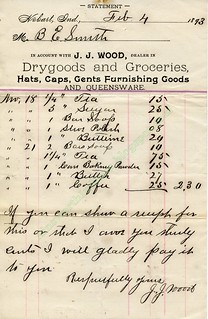 (Click on image to enlarge)
(Click on image to enlarge)
Notwithstanding these appearances in Hobart, it seems that Bernett Elfonso also spent time in Illinois, probably Chicago: in 1888 he married Helen Brown in Cook County, and by 1900 they were living in Chicago with their young daughter, Sarah. At that time B.E. worked as a teamster.
But sometime after 1900 the family moved to California. The
1910 Census shows them in Pasadena (B.E. working as an "investigator" for a gas and electric company), and the
1920 Census shows B.E. and his wife farming in Fresno County (their daughter having moved out of the house and married). On May 30, 1929, B.E. Smith died in Fresno.
[3]
 (Click on image to enlarge)
(Click on image to enlarge)
Fresno Morning Republican, 3 June 1929.
♦ ♦ ♦
Having found that last death notice, I thought I had settled the whole life of Bernett Elfonso Smith, so you can imagine my confusion when I came across this obituary in the
Hobart Gazette of October 29, 1942:
 (Click on image to enlarge)
(Click on image to enlarge)
Could there possibly be
two Bernett Elfonso Smiths in Hobart's history? Unlikely as it seems, the answer is yes. The one who died in 1942 was the nephew of the one who died in 1929: the son of his elder brother, George.
_______________
[1] In the Union Sunday School record book that begins in 1868, a scholar named "Burnett" and one named "Alphonso" are (or is) recorded, although the actual dates of attendance are unclear.
[2] The 1880 census of Hobart is very hard to read, so the name could easily be mistranscribed; but I have looked through all 30 pages of it on Ancestry.com without being able to find Fannie or Bernett Elfonso — only her son/his brother, Frank Smith.
[3] The commercial papers in this post and my previous post about B.B. Bale (as well as another post to come) all came from a seller in Fresno.


